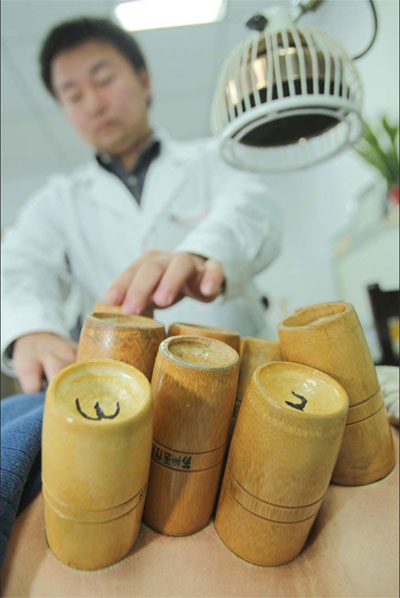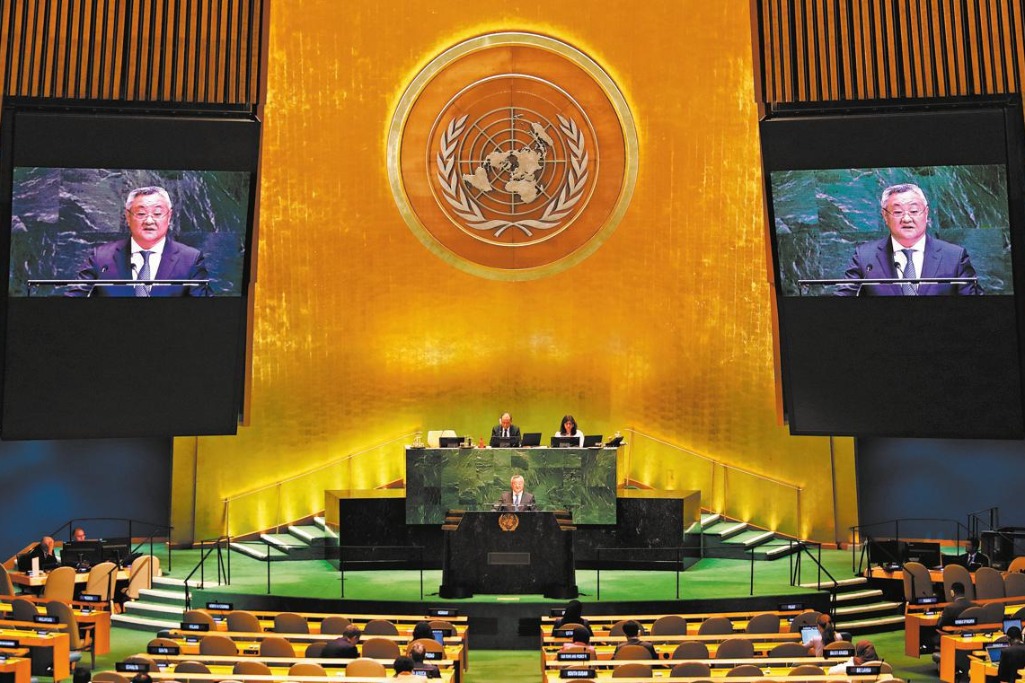Cups that runneth over with healing

|
Cups made of bamboo, iron and pottery are still used by some acupuncturists in China. Xu Congjun / For China Daily |
With traditional chinese medicine, pain relief is just a cup and a flame away
Marisol Sanchez Fernandez is a young Spaniard who works for a busy graphic design company in Beijing. Recently she noticed that her neck and shoulders were beginning to ache and even to become numb.
"The doctor diagnosed that I was suffering from slight cervical spondylosis (the degeneration of neck joints), and my problem was not solved after I took ... Western medicines," Fernandez says.
A Chinese friend suggested that she try the traditional Chinese therapy of cupping.
"Through undergoing a course of treatment, my symptoms were ... alleviated," Fernandez says.
The treatment includes creating a vacuum by burning a wick inside a jar and quickly placing the jar on the selected area. According to the theory of traditional Chinese medicine, the ensuing vacuum and the effect of suction helps draw out inner toxins, promotes the flow of "qi" and blood and unblocks channels called meridians, easing swelling and reducing pain.
Historical records on cupping date back to the Qin Dynasty (221-206 BC), when it was called horn therapy. It gradually developed in the Southern and Northern Dynasties (AD 420-581), was a Taoist medical practice and was widely used in the courts of Imperial China. In the Sui Dynasty (AD 581-618) and the Tang Dynasty (AD 618-907), the cupping implement was improved, and a bamboo jar replaced animal horns. In the Ming Dynasty (1368-1644), cupping had become a key treatment in traditional Chinese medicine. The present name was coined in the Qing Dynasty (1644-1911) when the jar used began to be made of pottery.
These days most acupuncturists use cups made of thick glass or plastic, although bamboo, iron and pottery cups are still used in some places. Glass cups are the preferred method, because they do not break as easily as pottery or deteriorate like bamboo, and they allow doctors to observe the skin and evaluate the effects of treatment.
Jacques Le Bert, a Frenchman who has studied traditional Chinese medicine in China for five years, says cupping is related to what is called the theory of meridians and collaterals, and is seeing increasing popularity in the West.
Meridians and collaterals are said to "connect different parts of the body into an organic whole, including the viscera, limbs, five sensory organs and nine orifices", Jacques says.
Central to the traditional Chinese medicine philosophy of yin and yang, which represent a range of opposite elements in the universe, are: day and night, cold and hot, slow and fast, quiet and moving, masculine and feminine, water and fire. In general, anything that is warming, moving, rising, bright, progressing, including functional diseases, is said to belong to yang. The characteristics of cooling, stillness, falling, darkness and degeneration, including structural diseases, belong to yin.
"For starters it would be best to view cupping based on its philosophical principle," Jacques says. "Traditional Chinese medicine believes in the balance between yin and yang. These can be translated to positive and negative energies. For example, if too much toxin makes its way into your inner system, it will create enormous disruptions in your body that could lead to sickness. In like manner, if cold air packets have penetrated your muscles nerves, it could cause common sickness and pains."
The Chinese movie Gua Sha Treatment, released in 2001, was a story about cultural conflicts in a Chinese family in the United States, in particular a misunderstanding about traditional Chinese medicine. In the film the grandfather of a child left with scrape marks on his back after treatment for a fever is accused of child abuse.
While scraping and cupping fall under the same theory, cupping is considered relatively painless. It can cause some swelling and bruising on the skin. As the skin under a cup is drawn up, the blood vessels at the surface of the skin expand.
There are several methods of cupping, one of them called "sustained cupping". "After the cup is sucked onto the skin, it is kept in place for about 10 minutes for an adult and three minutes for a child to induce a stagnant state of the skin, and then the cup is removed," says Zhou Peijuan, a hospital acupuncturist at the Beijing University of Chinese Medicine. "This is the most common method ... and can be used to treat many common diseases."
Another method, called movable cupping, combines two methods of treatment: cupping and scraping, Zhou says. Before cupping, a small amount of lubricant is placed on the skin, the cup is sucked onto the skin, and is forcibly slid back and forth along a selected line until a bruise is formed. The cup is then removed.
In a third method, quick cupping, the cup is sucked to the skin, immediately removed then put back again. This procedure is repeated until the treated skin turns red.
Cupping is recommended for ailments including acute colds, gastro-intestinal disorders, chronic cough and asthma, paralysis and atrophy.
Contraindications or cautions include hemophilia or bleeding disorders, inflamed skin or open wounds, fever, heart problems, and pregnancy.
Cupping is used to improve circulation and stimulate the peripheral nervous system, but deciding what the appropriate remedy should be is crucial, because cupping is not a universal remedy, Zhou says.
Today's Top News
- Economy seen on steady track
- Trade-in program likely to continue next year
- Li: SCO can play bigger role in governance
- Huangyan Island protection lifeline for coral ecosystem
- Latin America urgently needs green credit
- AI innovation powers China's lead in smart eyewear































